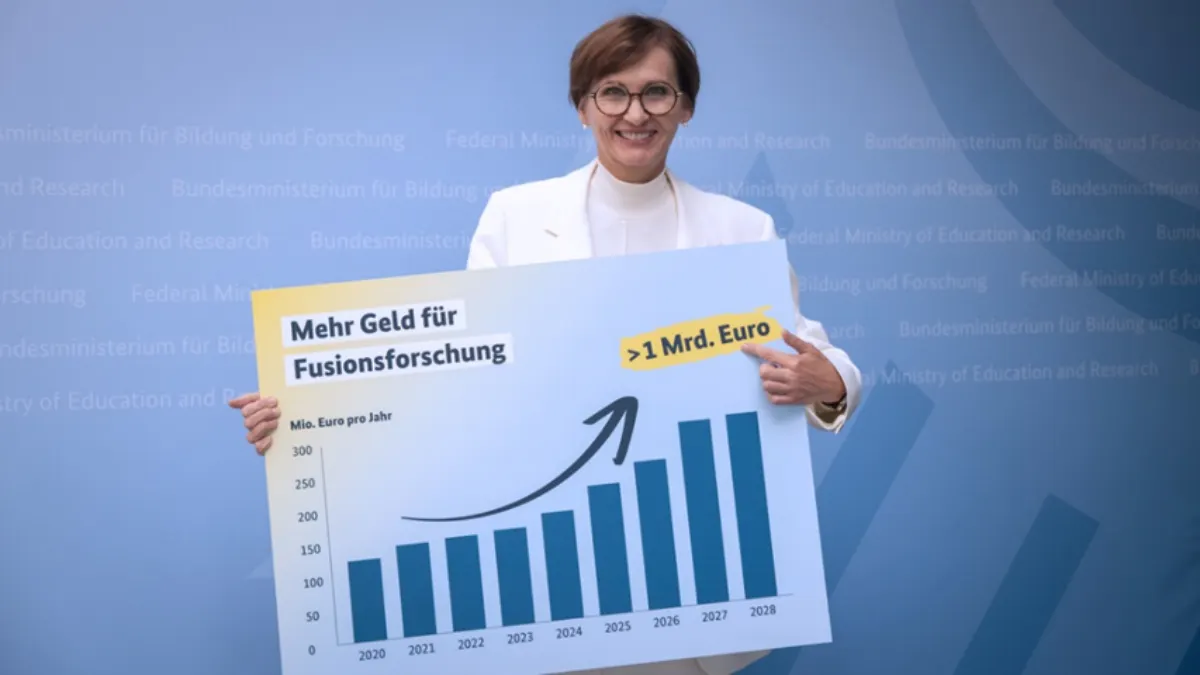Germany announces new fusion programme
By Cyd Cowley
Bettina Stark-Watzinger, the German Minister for Education and Research, announced a new public programme for fusion on the 5th of September.
How does this new plan change the level of funding and commitment for fusion in Germany? What will it mean for the fusion industry in Germany, and what steps does this new plan take towards realising a pilot fusion power plant on German soil?
What have they done? - Stepping up Funding for Fusion
The most significant change from this announcement concerns the most important resource in the development of fusion: money.
While the budget planning process in Germany for 2024 is still ongoing (to be finalised in December), Federal Minister Stark-Watzinger announced in an official press statement the intention to "invest massively and openly in fusion technology" that will include steps towards a fusion power plant.
Minister Stark-Watzinger announced that an additional €370 million will be contributed to the German fusion programme over the next five years. Combined with the existing funding, this will exceed €1 billion to fusion research from 2024 to 2028.

Federal Minister Bettina Stark-Watzinger presenting a new funding programme for fusion research. © BMBF/Hans-Joachim Rickel
Why is it impressive? - Building A Fusion Ecosystem
As well as the funding, there is also a clear intention from the German government to build a fusion supply chain and collaborate more with the private sector. The government is thinking about fusion more as a commercial venture than a science project.
Minister Stark-Watzinger said: “We want to create a fusion ecosystem with industry so that a fusion power plant can become a reality in Germany as soon as possible. The question is no longer whether fusion will come. The question is whether Germany will be part of it. That's my goal.”

An artist’s impression of Marvel Fusion’s future power plant. Nuclear fusion technology could provide a virtually limitless energy supply with a very low environmental footprint. © Marvel Fusion
This will no doubt involve collaboration with the now numerous German fusion companies, including Focused Energy, Marvel Fusion and Proxima Fusion. However, the new plan also involves the German government establishing its own subsidiary, “Pulsed Light Technologies GmbH”. This company will focus on researching key fusion-enabling technologies that are not a core IP of other companies—technologies such as laser systems, diagnostics, robotics and plasma simulations.
Why is it important? - Towards a Fusion Pilot Plant
Overall, this new programme demonstrates the German government is committed to creating a fusion power plant in Germany sooner rather than later.
What approaches will they be exploring with this new program? Both laser and magnetic fusion approaches.
Laser fusion seems to be a significant focus of the government at present, perhaps stimulated by the National Ignition Facility achieving energy gain last year.
The German Federal Ministry of Education and Research (BMBF) created an expert commission on laser fusion in late 2022, headed by Prof. Constantin Häfner from Fraunhofer ILT. Earlier this year, the commission produced a memorandum focused on the potential of Inertial Fusion Energy and recommendations to realise a commercial laser fusion power plant. It was presented in May.
In particular, the memorandum document calls for a much more aggressive laser fusion programme and highlights the key technological challenges and opportunities on the way to a pilot plant. It is recommended that some of these technologies, such as high-performance computing, should be a high priority for government institutions whilst others, such as target design, can be left mostly to the private sector.

However, the memorandum also recommends continued investment in magnetic fusion, so that the combined resources of both methods can be used to solve shared technological problems. After all, Germany is home to some world-leading magnetic fusion projects, such as the tokamak ASDEX-U and the stellarator W7-X.
The government clearly recognises that increased investment into all forms of fusion is necessary to get there, regardless of what form the eventual fusion power plant takes.
Constantin Häfner says: “While the actual allocation of funds is still being planned, this announcement represents a major step towards positioning Germany as a capable partner on the path towards a fusion power plant.”
What’s next?
For the first time, there will now be an integrated program that supports both inertial fusion energy (IFE) and magnetic fusion energy. The budget planning process for 2024 will be finalised in December. This sets in motion the fusion budget from 2024-2028, but it is likely momentum will have to keep building beyond 2028. After all, the German IFE memorandum submitted in May suggested an aggressive inertial fusion program could result in a demonstration inertial fusion powerplant by 2045. So though this new budget is an exciting start, long-term consistency is likely required for the eventual goal of fusion energy produced in Germany.
